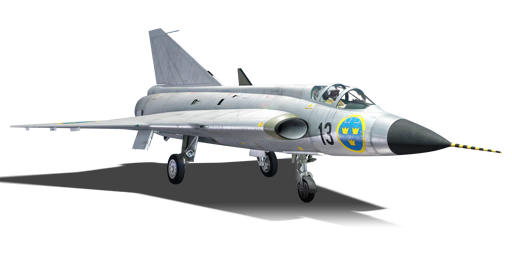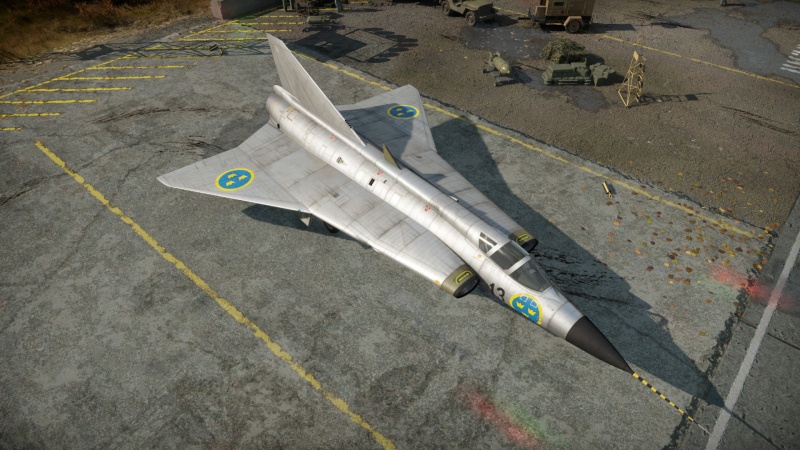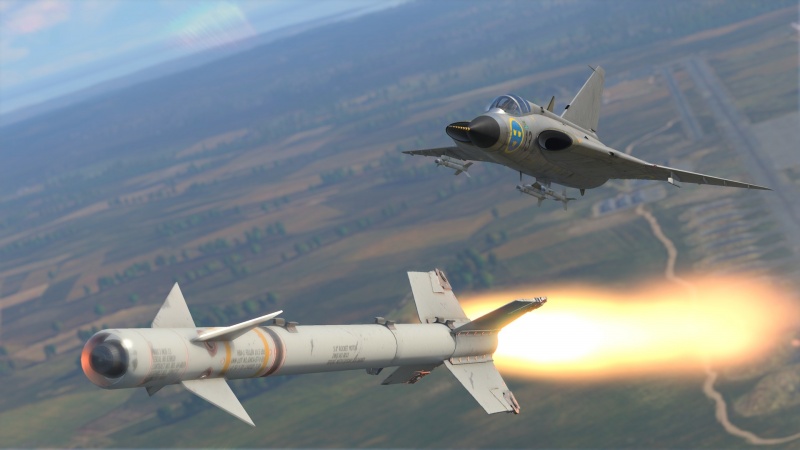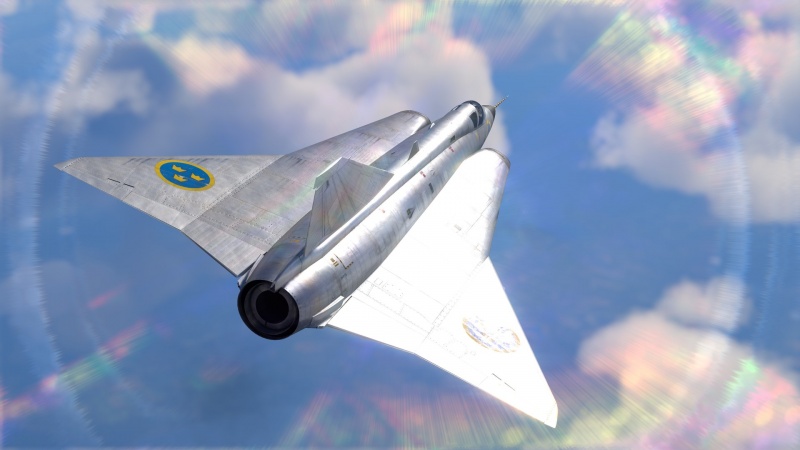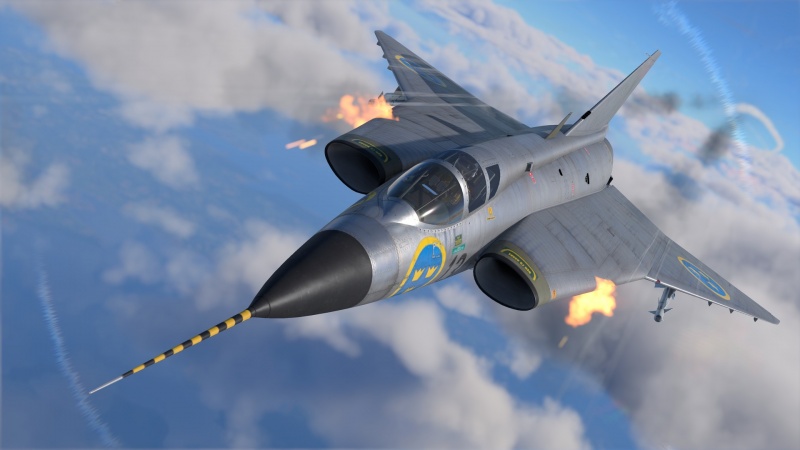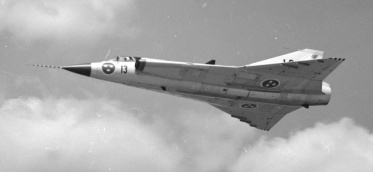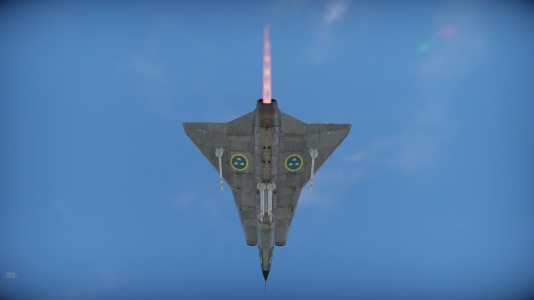Difference between revisions of "J35A"
m (→Pros and cons) (Tag: Visual edit) |
Colok76286 (talk | contribs) (Edits) |
||
| Line 148: | Line 148: | ||
1-vs-1 situation: In a 1-vs-1 turn fight, the {{PAGENAME}} is one of the best in the game. Its superior turning ability makes it very easy to out-turn the enemy and send a couple 30 mm round their way. Enemies to beware of in a 1-vs-1 are F-5C (very good at turning also and keeps the energy a little bit better than the J35A, in a prolonged dogfight the F-5C can come on top if you get too slow) and MiG-19s/PT (The best rate fighter in the game, if you can drag him into a 1 or 2 circle fight he will be very easy to target, but if the energy/rate fight begins, you may find yourself in a sticky situation) | 1-vs-1 situation: In a 1-vs-1 turn fight, the {{PAGENAME}} is one of the best in the game. Its superior turning ability makes it very easy to out-turn the enemy and send a couple 30 mm round their way. Enemies to beware of in a 1-vs-1 are F-5C (very good at turning also and keeps the energy a little bit better than the J35A, in a prolonged dogfight the F-5C can come on top if you get too slow) and MiG-19s/PT (The best rate fighter in the game, if you can drag him into a 1 or 2 circle fight he will be very easy to target, but if the energy/rate fight begins, you may find yourself in a sticky situation) | ||
| − | One weak area of the J35A are its two 30 mm Akan m/55 cannons. While they do very high damage upon hitting, shell velocity is low, ammo capacity is low (only 100 rounds per gun) | + | One weak area of the J35A are its two 30 mm Akan m/55 cannons. While they do very high damage upon hitting, shell velocity is low, ammo capacity is low (only 100 rounds per gun). The low velocity makes accurate aiming for the average player difficult. Due to these factors, it is recommended that you exercise strong trigger discipline to conserve ammo and only fire on slow enemies at closer ranges (<750 m). |
=== Pros and cons === | === Pros and cons === | ||
| Line 155: | Line 155: | ||
'''Pros:''' | '''Pros:''' | ||
| − | * Superior | + | * Superior manoeuvrability at all speeds |
* Good energy retention at higher speeds (above 850 km/h) | * Good energy retention at higher speeds (above 850 km/h) | ||
* High top speed | * High top speed | ||
| Line 168: | Line 168: | ||
* Relatively low maximum fuel load and a fuel thirsty afterburner | * Relatively low maximum fuel load and a fuel thirsty afterburner | ||
* Wings may rip with roll and elevator input at transonic speeds | * Wings may rip with roll and elevator input at transonic speeds | ||
| − | * Cannons are placed fairly far from the center (convergence issue) | + | * Cannons are placed fairly far from the center (convergence issue) |
* Cannons have low velocity and ammo | * Cannons have low velocity and ammo | ||
* Only has unguided rockets for CAS | * Only has unguided rockets for CAS | ||
* Lacks countermeasures: no flares or RWR | * Lacks countermeasures: no flares or RWR | ||
* RB24 missiles are weak and easily avoided by enemies | * RB24 missiles are weak and easily avoided by enemies | ||
| − | * Unstable wing design; if not careful can easily enter an unrecoverable stall or flat spin when | + | * Unstable wing design; if not careful can easily enter an unrecoverable stall or flat spin when manoeuvring at low speeds |
== History == | == History == | ||
<!-- ''Describe the history of the creation and combat usage of the aircraft in more detail than in the introduction. If the historical reference turns out to be too long, take it to a separate article, taking a link to the article about the vehicle and adding a block "/History" (example: <nowiki>https://wiki.warthunder.com/(Vehicle-name)/History</nowiki>) and add a link to it here using the <code>main</code> template. Be sure to reference text and sources by using <code><nowiki><ref></ref></nowiki></code>, as well as adding them at the end of the article with <code><nowiki><references /></nowiki></code>. This section may also include the vehicle's dev blog entry (if applicable) and the in-game encyclopedia description (under <code><nowiki>=== In-game description ===</nowiki></code>, also if applicable).'' --> | <!-- ''Describe the history of the creation and combat usage of the aircraft in more detail than in the introduction. If the historical reference turns out to be too long, take it to a separate article, taking a link to the article about the vehicle and adding a block "/History" (example: <nowiki>https://wiki.warthunder.com/(Vehicle-name)/History</nowiki>) and add a link to it here using the <code>main</code> template. Be sure to reference text and sources by using <code><nowiki><ref></ref></nowiki></code>, as well as adding them at the end of the article with <code><nowiki><references /></nowiki></code>. This section may also include the vehicle's dev blog entry (if applicable) and the in-game encyclopedia description (under <code><nowiki>=== In-game description ===</nowiki></code>, also if applicable).'' --> | ||
| − | The J-35 was a revolutionary design for its time and was developed and manufactured between 1955 and 1974. However, the development started in 1948 as a replacement for the J29 and J32B night fighter. Unlike any other design of its era, it featured a double delta wing, it was also the first fully supersonic aircraft to be deployed in Western Europe, being one of the first to reach Mach 2 in level flight, its unconventional wing design made it capable of performing insane manoeuvres and acrobatics, like the infamous Cobra | + | The J-35 was a revolutionary design for its time and was developed and manufactured between 1955 and 1974. However, the development started in 1948 as a replacement for the J29 and J32B night fighter. Unlike any other design of its era, it featured a double delta wing, it was also the first fully supersonic aircraft to be deployed in Western Europe, being one of the first to reach Mach 2 in level flight, its unconventional wing design made it capable of performing insane manoeuvres and acrobatics, like the infamous Cobra Manoeuvre. |
Intended as an interceptor, it took the role of the J29 Tunnan as the backbone of the Swedish Air Force and the role of the J32B Lansen as a night fighter, combining the capabilities of both fighters, thus creating a dangerous dogfighter, with supersonic performance and all-weather capabilities. Upgraded in several programs, with the last model being the J35J, the Draken was eventually replaced by the JA 37 Viggen. The Draken was very expensive to operate however, and it was retired in December 1999, before expected, but it was also exported to Austria, Denmark and Finland, being the first its last user.[[File:J35A1.jpg|thumb|373x373px|J35A1 (kort) 1960]]The '''J35A (Adam)''' was the first production version of the Draken. With 90 aircraft delivered between 1960 and 1961. The initial batch was equipped without radar and gunsight, which was corrected in 1961, with the next units being delivered with gunsight and radar. 25 of these last J35As were converted to the Saab 35C, a two-seat trainer to introduce new pilots to the aircraft. Two types of afterburners and airframes resulted in two versions. The '''J35A (kort)''' had a short afterburner and a short tail (65 units built). The '''J35A Long''' on the other hand housed a new afterburner with additional thrust as well as a longer tail section, which reduced drag but forced the installation of a retractable tail wheel (25 units built), this last design would be the one used for future J35 fighters. | Intended as an interceptor, it took the role of the J29 Tunnan as the backbone of the Swedish Air Force and the role of the J32B Lansen as a night fighter, combining the capabilities of both fighters, thus creating a dangerous dogfighter, with supersonic performance and all-weather capabilities. Upgraded in several programs, with the last model being the J35J, the Draken was eventually replaced by the JA 37 Viggen. The Draken was very expensive to operate however, and it was retired in December 1999, before expected, but it was also exported to Austria, Denmark and Finland, being the first its last user.[[File:J35A1.jpg|thumb|373x373px|J35A1 (kort) 1960]]The '''J35A (Adam)''' was the first production version of the Draken. With 90 aircraft delivered between 1960 and 1961. The initial batch was equipped without radar and gunsight, which was corrected in 1961, with the next units being delivered with gunsight and radar. 25 of these last J35As were converted to the Saab 35C, a two-seat trainer to introduce new pilots to the aircraft. Two types of afterburners and airframes resulted in two versions. The '''J35A (kort)''' had a short afterburner and a short tail (65 units built). The '''J35A Long''' on the other hand housed a new afterburner with additional thrust as well as a longer tail section, which reduced drag but forced the installation of a retractable tail wheel (25 units built), this last design would be the one used for future J35 fighters. | ||
Revision as of 05:12, 4 March 2024
| This page is about the premium Swedish jet fighter J35A. For other versions, see SAAB 35 Draken (Family). |
Contents
Description
The J35A was the first version of the J35, with a total of 90 units built between the two versions. The J35A1 (kort) had a short afterburner and a short tail. Meanwhile, the J35A2 (long) had a new afterburner with increased thrust, which meant that the tail section needed to be extended. While unexpectedly, this reduced drag, it forced the installation of a retractable tail wheel. The first batch produced in 1960 lacked gunsights and radar, which was a big mistake by the manufacturer, however, in 1961 the remaining units were delivered with the radar and gunsight installed. The J35 was the attempt by Sweden to create a domestic fighter that could replace both the J29 Tunnan and the J32B Lansen. Thus the J35 has many records, including being the first fully supersonic aircraft deployed in Western Europe.
Introduced in Update "Direct Hit", it was removed at the end of the 2023 May Sale and is briefly made available on some occasions The J35A is a capable aircraft for its BR, but it has a few caveats that hamper its performance. For example, the J35A does not have access to any sort of countermeasures, playing safely and with good situational awareness is crucial, since many aircraft like the A-10, Su-25, F-8s and Mig-21SMT/MF to mention just a few, have access to excellent missiles that are very hard to dodge without flares. Thus the J35A needs to remain fast, so it can outrun most missiles and force enemies to do bad launches. It has access to 4 x Rb-24 missiles, which are AIM-9Bs, they are agile and have a decent range, thus they can be used from high altitudes to be dropped on unsuspected enemies.
General info
Flight performance
| Characteristics | Max Speed (km/h at 9,000 m) |
Max altitude (metres) |
Turn time (seconds) |
Rate of climb (metres/second) |
Take-off run (metres) | |||
|---|---|---|---|---|---|---|---|---|
| AB | RB | AB | RB | AB | RB | |||
| Stock | 2,141 | 2,084 | 12500 | 25.9 | 26.9 | 139.2 | 127.6 | 900 |
| Upgraded | 2,357 | 2,250 | 24.1 | 25.0 | 194.4 | 165.0 | ||
Details
| Features | |||||
|---|---|---|---|---|---|
| Combat flaps | Take-off flaps | Landing flaps | Air brakes | Arrestor gear | Drogue chute |
| X | X | X | ✓ | X | ✓ |
| Limits | ||||||
|---|---|---|---|---|---|---|
| Wings (km/h) | Gear (km/h) | Flaps (km/h) | Max Static G | |||
| Combat | Take-off | Landing | + | - | ||
| 1,417 | 500 | - | - | - | ~13 | ~5 |
| Optimal velocities (km/h) | |||
|---|---|---|---|
| Ailerons | Rudder | Elevators | Radiator |
| < 850 | < 700 | < 700 | - |
Engine performance
| Engine | Aircraft mass | |||||
|---|---|---|---|---|---|---|
| Engine name | Number | Basic mass | Wing loading (full fuel) | |||
| Svenska Flygmotor RM6B | 1 | 7,605 kg | 189 kg/m2 | |||
| Engine characteristics | Mass with fuel (no weapons load) | Max Takeoff Weight | ||||
| Weight (each) | Type | 6m fuel | 20m fuel | 21m fuel | ||
| 1,400 kg | Afterburning axial-flow turbojet | 8,124 kg | 9,232 kg | 9,335 kg | 13,500 kg | |
| Maximum engine thrust @ 0 m (RB/SB) | Thrust to weight ratio @ 0 m (WEP) | |||||
| Condition | 100% | WEP | 6m fuel | 20m fuel | 21m fuel | MTOW |
| Stationary | 4,696 kgf | 6,763 kgf | 0.83 | 0.73 | 0.72 | 0.50 |
| Optimal | 4,790 kgf (1,417 km/h) |
9,080 kgf (1,417 km/h) |
1.12 | 0.98 | 0.97 | 0.67 |
Survivability and armour
Examine the survivability of the aircraft. Note how vulnerable the structure is and how secure the pilot is, whether the fuel tanks are armoured, etc. Describe the armour, if there is any, and also mention the vulnerability of other critical aircraft systems.
Modifications and economy
Armaments
Offensive armament
The J35A is armed with:
- 2 x 30 mm Akan m/55 cannons, wing-mounted (100 rpg = 200 total)
Suspended armament
The J35A can be outfitted with the following ordnance:
- Without load
- 12 x m/56D rockets
- 4 x RB24 missiles
- 2 x RB24 missiles + 12 x m/56D rockets
Usage in battles
Downtier: In a downtier, the J35A is one of the best planes in the match. With superior speed, acceleration and manoeuvrability, the J35A is almost unstoppable. Start off by climbing to around 20,000 ft (~6,000 m) and then levelling off to enter supersonic speeds, here you will have every advantage over your enemies, fire a missile or get close with your high top speed and take them down with your guns.
Uptier: In an uptier, there will be more vehicles that can match your performance with speeds (T-2, MiG-19, F-104, F-105, Lightning) so it will be much harder to get close and fire an unexpected missile. These higher performing planes also make it much harder to get away with a 1-vs-1 turn fight, as seeing a slow Draken will attract almost anyone's attention and you'll find yourself with a missile coming your way. It is recommended to avoid aproaching enemy vehicles head-on and instead to attack slow targets like attackers from behind when they dont expect it. Alternatively, its m/56D rockets can be used as flares against missiles from the front and side. Always try to keep up higher speeds, using the J35A's good acceleration to regain the lost speed after a turn.
1-vs-1 situation: In a 1-vs-1 turn fight, the J35A is one of the best in the game. Its superior turning ability makes it very easy to out-turn the enemy and send a couple 30 mm round their way. Enemies to beware of in a 1-vs-1 are F-5C (very good at turning also and keeps the energy a little bit better than the J35A, in a prolonged dogfight the F-5C can come on top if you get too slow) and MiG-19s/PT (The best rate fighter in the game, if you can drag him into a 1 or 2 circle fight he will be very easy to target, but if the energy/rate fight begins, you may find yourself in a sticky situation)
One weak area of the J35A are its two 30 mm Akan m/55 cannons. While they do very high damage upon hitting, shell velocity is low, ammo capacity is low (only 100 rounds per gun). The low velocity makes accurate aiming for the average player difficult. Due to these factors, it is recommended that you exercise strong trigger discipline to conserve ammo and only fire on slow enemies at closer ranges (<750 m).
Pros and cons
Pros:
- Superior manoeuvrability at all speeds
- Good energy retention at higher speeds (above 850 km/h)
- High top speed
- Good climb performance
- Good acceleration
- Low stall speed
- Hard-hitting 30 mm cannons
Cons:
- Bleeds energy quickly at lower speeds (below 750 km/h)
- Relatively low maximum fuel load and a fuel thirsty afterburner
- Wings may rip with roll and elevator input at transonic speeds
- Cannons are placed fairly far from the center (convergence issue)
- Cannons have low velocity and ammo
- Only has unguided rockets for CAS
- Lacks countermeasures: no flares or RWR
- RB24 missiles are weak and easily avoided by enemies
- Unstable wing design; if not careful can easily enter an unrecoverable stall or flat spin when manoeuvring at low speeds
History
The J-35 was a revolutionary design for its time and was developed and manufactured between 1955 and 1974. However, the development started in 1948 as a replacement for the J29 and J32B night fighter. Unlike any other design of its era, it featured a double delta wing, it was also the first fully supersonic aircraft to be deployed in Western Europe, being one of the first to reach Mach 2 in level flight, its unconventional wing design made it capable of performing insane manoeuvres and acrobatics, like the infamous Cobra Manoeuvre.
Intended as an interceptor, it took the role of the J29 Tunnan as the backbone of the Swedish Air Force and the role of the J32B Lansen as a night fighter, combining the capabilities of both fighters, thus creating a dangerous dogfighter, with supersonic performance and all-weather capabilities. Upgraded in several programs, with the last model being the J35J, the Draken was eventually replaced by the JA 37 Viggen. The Draken was very expensive to operate however, and it was retired in December 1999, before expected, but it was also exported to Austria, Denmark and Finland, being the first its last user.The J35A (Adam) was the first production version of the Draken. With 90 aircraft delivered between 1960 and 1961. The initial batch was equipped without radar and gunsight, which was corrected in 1961, with the next units being delivered with gunsight and radar. 25 of these last J35As were converted to the Saab 35C, a two-seat trainer to introduce new pilots to the aircraft. Two types of afterburners and airframes resulted in two versions. The J35A (kort) had a short afterburner and a short tail (65 units built). The J35A Long on the other hand housed a new afterburner with additional thrust as well as a longer tail section, which reduced drag but forced the installation of a retractable tail wheel (25 units built), this last design would be the one used for future J35 fighters.Media
- Skins
- Images
See also
Links to the articles on the War Thunder Wiki that you think will be useful for the reader, for example:
- reference to the series of the aircraft;
- links to approximate analogues of other nations and research trees.
External links
- [Development] Perfect interceptor JA37C Jaktviggen and Premium J35A Draken
- Official data sheet - more details about the performance
- [Wikipedia] - Saab J35 Draken
| Swedish Aeroplane Company Ltd. (SAAB) | |
|---|---|
| Pre-SAAB: SA / ASJA | |
| SA 'Jaktfalken' | J6B |
| SAAB 17 | B17A · B17B · S17BS |
| SAAB 18 | B18A · B18B · T18B · T18B (57) |
| SAAB 21 | J21A-1 · J21A-2 · A21A-3 · J21RA · A21RB |
| SAAB 29 'Tunnan' | J29A · A29B · J29D · J29F |
| SAAB 32 'Lansen' | J32B · A32A · A32A Röd Adam |
| SAAB 35 'Draken' | J35A · J35D |
| SAAB 37 'Viggen' | JA37C · JA37D · JA37DI · JA37DI F21 · AJ37 · AJS37 |
| SAAB 39 'Gripen' | JAS39A · JAS39C |
| SAAB 105 | SK60B · SAAB-105G |
| License Production | B3C (Ju 86K) |
| Export | SAAB-105OE · J35XS · ▄JAS39C · ◔JAS39EBS HU C |
| Sweden jet aircraft | |
|---|---|
| Fighters | J21RA |
| J29A · A29B · J29D · J29F | |
| J32B | |
| J34 | |
| J35A · J35D | |
| JA37C · JA37D · JA37DI · JA37DI F21 | |
| JAS39A · JAS39C | |
| Strike aircraft | A21RB |
| A32A · A32A Röd Adam | |
| A28B | |
| AJ37 · AJS37 | |
| SK60B · SAAB-105G | |
| Export | SAAB-105OE |
| Finland | ▄Vampire FB 52A · ▄MiG-21bis · Saab J35XS |
| Sweden premium aircraft | |
|---|---|
| Fighters | Iacobi's J8A · ▄Fokker D.XXI · Mörkö-Morane · VL Myrsky II · J9 Early · J26 David · VL Pyörremyrsky · ▄Bf 109 G-6 |
| Jet fighters | J29D · J35A · Saab J35XS · JA37DI F21 |
| Strike aircraft | SAAB-105OE · A32A Röd Adam |
| Bomber | ▄Ar 196 A-5 |


